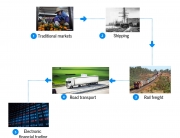From this
To this
Or a combination of the traditional and the new?
In his book, The Tipping Point, Malcolm Gladwell outlined the key characteristics of “The Tipping Point “. This is the point of critical mass, where an idea goes from interesting to a few to must-have for everybody.
In the training world is 2018 the year in which a tipping point has been reached in terms of “digital training”?
Digital and remote learning tools are not new, but several factors are occurring which could lead to digital training becoming “a mass market product” In my view several factors have come together which are likely to result in acceleration of growth in digital training, including
i. Escalating cost of traditional training, both in academic institutions and in a corporate environment, has resulted in people questioning “value for money”
ii. Rapid improvement in technology has facilitated the growth of webinars and other on and off line digital training formats
iii. Falling costs for digital training
iv. Convenience of use
v. Promotion of digital learning on social / business media platforms such as LinkedIn which facilitates access
vi. Ability to use a range of software has improved the options for making digital training more engaging for users
So, what is likely to happen when a product reaches a tipping point?
I believe that the improvement in technology offers tremendous possibilities in terms of making training more accessible and affordable.
Based on experience in other industries we can expect that
i. Growth can be very rapid…..examples would include the use of Instagram and Netflix
ii. Higher growth drives down costs – in the energy sector the cost of electricity has plummeted as technologies such as wind and solar power have become financially viable with increased demand, prompted by government action (Kyoto Accord, 20/20 objectives), combined with the fact that fossil fuels had become expensive pre the Global Financial Crisis
iii. There will be more choice of providers, but some will fail / perform poorly. Pioneers, like Blackberry, may lead a revolution but their competitive advantage can rapidly erode
iv. After the period of exponential growth there will be consolidation in the relevant industry. Most likely, as in English language social media platforms, 2 or 3 dominant players will emerge
v. In the rush to get products to market there is the likelihood that product quality will be variable
So, what are the implications for training of the growth in digital media and training platforms?
i. Training providers will be expected to offer a digital training solution where it is feasible
ii. After a period of enthusiasm, it will become apparent that digital training is not a solution for all training needs as it may not engage students’ interests sufficiently for training to be fully effective. Good quality engaging content will be essential
iii. “novelty” may be of interest at first, but those organisations that produce mediocre quality training are unlikely to survive. As we have seen in the growth of cable and satellite TV there may be more channels, but there will always be some “stand out” programmes
iv. Although enthusiasm for digital training will decrease over time, it is likely to become increasingly important in the “market share” of training spend
v. The overall market for training will expand as the economies of scale and lack of geographical limitations arising from the use of technology will make training more affordable and accessible
vi. Formal training will become less necessary as technology will allow students to study at their own pace and convenience
vii. Training delivery methods could be seen as brands, ranging from basic skills to premium, highly tailored solutions. Over time digital training will provide more “virtual reality” but it is difficult to emulate the spontaneity and personal interaction that is provided by classroom based training
viii. Rather than “one off” training events, digital learning can improve the effectiveness of some training as it offers a convenient option for continuous learning
ix. Technology will make it easier to track the effectiveness of training. Benchmarking performance will become easier in technical topics, both within, and also in comparison with, other organisations
How will digital learning impact traditional classroom based training?
In my view
i. Some topics, particularly those involving behavioural / interpersonal skills, are best in an environment where there is human interaction
ii. Each learning technique has its own characteristics. If we use the analogy of the entertainment industry it has evolved over time from local to global performances, and different media such as “live entertainment” such as theatres to “mass media” such as radio, Television and internet based services such as Netflix. People will continue to want access to a range of entertainment…choices will continue to be influenced by cost and convenience, as well as emotional involvement in an event
For the above reasons, classroom based training will continue to be an important way of providing training but it will cease to be the “default option”.
Will strong training programmes be a factor in recruiting personnel?
The recent trend towards a “gig economy” is not in my view a passing fad. It is a reversion to an economic environment where people are less likely to find financially rewarding jobs that continue with the same organisation over long periods. Personal qualities such as adaptability and determination, as well as strong interpersonal skills will become more important in a rapidly changing environment.
Organisations that provide employees with ongoing opportunities to learn will become increasingly attractive to people with strong potential.
In conclusion
i. This is not the time to be complacent or to meet just minimum standards
ii. Move fast to respond to what people want from training, including delivering what is wanted on demand
iii. Technological advances will expand access to training and improve affordability.
iv. Training providers and facilitators will need to constantly adapt to take advantage of the benefits of technology
Using the example of the retail industry we can see the impact of Amazon and other digitally based shopping services and how it is affecting traditional retailers that have not adapted sufficiently quickly to technological change.
v. People will continue to want choice
Some people will want easily accessible short duration training sessions. Others will want highly tailored training solutions that require the personal interaction that is provided by classroom based training
vi. There is plenty of room for both traditional and digital training solutions
As known Amazon has purchased Whole Foods. It’s too early to tell what’s in store, but there are already price cuts in Whole Foods stores, and there are still people employed to work in the stores. How people will work in the stores remains to be seen!
I may be wrong of course but using the example of Amazon I believe that the future of training will involve combining the benefits of technology with traditional solutions involving people who can provide the solutions, spontaneity and interpersonal skills and interaction that cannot be provided by technology alone.







Leave A Comment